
views
Using Graphite Paper Transfers
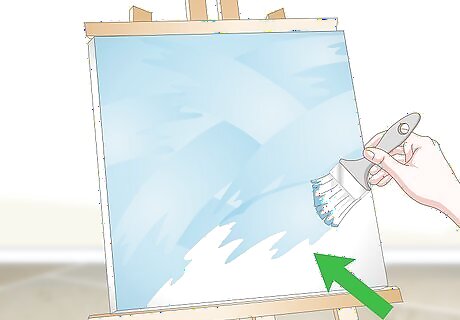
Paint the background of your canvas with acrylic paint. Depending on your artistic talent and preference, you can be as intricate or minimal as you like. Since you will be painting the letters of the quote over the background, paint on a design that is not too busy or the quote itself will be hard to read. You will want the letters and the background to contrast, so if you want light-colored lettering, paint the background dark, and if you want to have dark lettering, paint the background with lighter shades. If you want the look of exposed canvas, you can leave the canvas unpainted for this step. Using acrylic paint is best when painting in layers because it dries quickly and allows you add the next coat. Also, you don't have to worry about fumes like you do with oil paints.
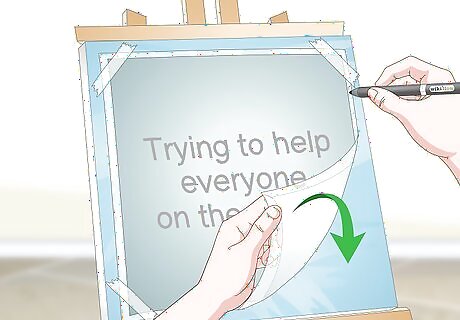
Transfer a printed quote to the canvas using graphite paper. Once your painted canvas is completely dry, place a sheet of graphite paper (graphite side down) onto the canvas and a printed copy of your chosen quote on the graphite paper. Using a moderate amount of pressure, but not too much to damage the canvas, trace the lines of the quote using a ballpoint pen. To keep the layers together, secure them with a few pieces of tape. If your canvas is larger than a sheet of printer paper, you can do this one line or one word at a time. Wash your hands after handling graphite paper as it can leave unwanted residue on your fingers that you accidentally transfer onto your canvas.
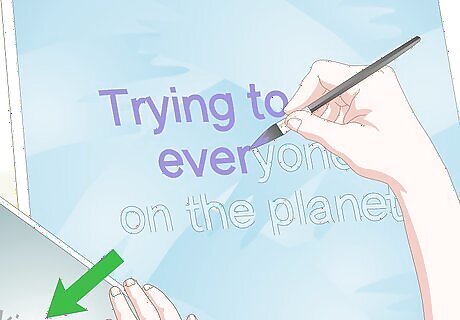
Remove the graphite paper and paint the letters with a paintbrush. Using acrylic paint in a color contrasting to the background, paint in the letters imprinted on the canvas by the graphite paper. If the background is very dark, allow the first coat to dry and apply another to make the quote really pop. When selecting a paintbrush size for this task, choose one small enough to allow you to paint the thinnest lines of your quote.

Erase any residual graphite marks with kneaded rubber. A slip of the pen or a scratch with a fingernail during the transfer process can result in little unwanted graphite marks on the canvas. You can easily rub them away with a pencil eraser or kneaded rubber to finish your art. You will have the best results with a small block of kneaded rubber that you can buy for a minimal cost at an art supply store. A standard pencil may cause smudging, depending on the darkness of the transfer and the color of the background.
Stenciling Quotes onto Canvas
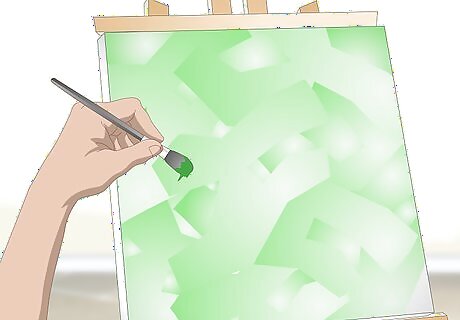
Paint the background of your canvas with acrylic paint. Depending on your artistic talent and preference, you can be as intricate or minimal as you like. Since you will be painting the letters of the quote over the background, paint on a design that is not too busy or the quote itself will be hard to read. You will want the letters and the background to contrast, so if you want light-colored lettering, paint the background dark, and if you want to have dark lettering, paint the background with lighter shades. If you want the look of exposed canvas, you can leave the canvas unpainted for this step.
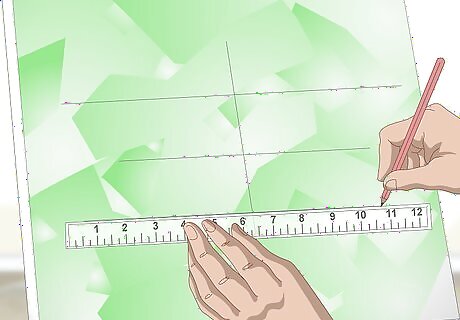
Measure and mark where you want the letters of your quote. After your background is completely dry, use a ruler and a pencil to make light lines across your painted background exactly where you want the letters of the quote to be painted. This will help you keep your stenciled letters straight. Plan out your entire quote on a piece of paper beforehand, taking into consideration the size of the stencils and the size of the canvas so you know exactly where you want your letters to go. If you have a custom-cut stencil and are not using individual letters to make your quote, you can skip this step.
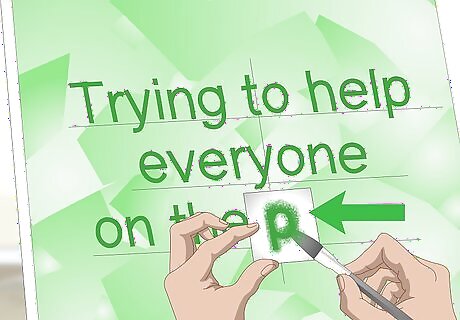
Stencil the quote onto the background using acrylic paint. Slowly and carefully lay the first letter of your quote down on the pencil line you made and paint over the entire letter. Then, lift the stencil straight up. Wash any excess paint off the stencil with a second wet paintbrush and dry with a paper towel. Repeat these steps for the rest of the quote. Use a minimal amount of paint on the brush when stenciling. Too much paint will cause it bleed out underneath the stencil and ruin the edges of the letter. If you accidentally put too much on the brush, dab off the excess on a dry paper towel. If you make a mistake, correct it quickly with a damp paper towel.
Applying Vinyl Letters as Reverse Stencils
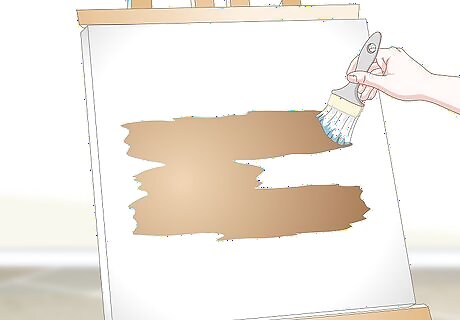
Cover the canvas with acrylic paint in the color that you want the letters. As with the other techniques, you will want the lettering and the background to be contrasting enough to make the letters easily readable. You can be as bold or simple as you want in choosing your colors and designs. You can also glue down bits of fabric or bits of colorful paper from magazines for a fun alternative to solid lettering. If you want white lettering, paint the canvas white instead of leaving it bare because the vinyl letters will not stick well to the rough canvas surface. If you want a patterned or bold background, go with solid lettering.

Stick your quote on the canvas with removable vinyl letter stickers. After your canvas has dried, place the vinyl letters on the canvas exactly as you want the quote to appear. Keep them straight and equally spaced using a ruler as a guide. Plan out your quote in advance on a separate piece of paper, taking into consideration the size of the letters and the canvas. Check and double-check that the stickers are removable.
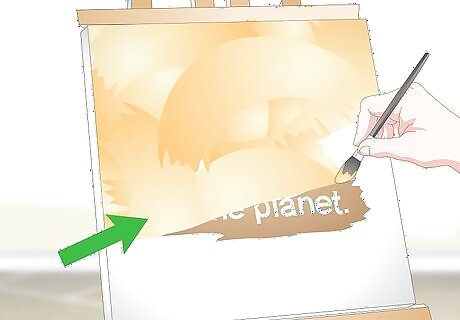
Paint the background on the canvas, completely covering the letters. Be gentle as your paint so that you don't move any of the letters or accidentally lift up their edges. Also, do not paint too thick a layer or the letters will not come off cleanly in the next step. You only need just enough paint to cover your first coating.

Peel off the vinyl letters to reveal your finished product. While the background is still a little wet and sticky to the touch, slowly peel off the letters one a time. If you have a hard time removing them, try using a pair of tweezers. If necessary, touch up any lines with a small paint brush. Don't throw away the letters. They can be used multiple times.
Writing Free Hand with Paint Pens
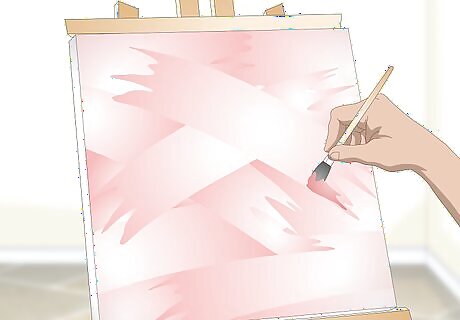
Paint a simple background on the canvas with acrylic paint. Since you will be hand-painting the quote, it will be easiest if the background is a solid color. As with the other techniques, choose a background color that will contrast with the color that you want the lettering. If you want more than a solid background, try an ombre gradient to add some extra color without being too distracting from the lettering.

Plan your quote on paper before you paint it on the canvas. Take into consideration the size of the canvas and how you want the final work to look. Sketch out exactly where you want all the words to go before you begin. Vary lettering styles (i.e. block and cursive/serif and sans-serif) in your quote for a more artistic appearance.

Write your quote on the canvas with a paint pen. After the background has dried completely, use a water-based paint pen or paint marker to slowly and carefully write the quote on your canvas. It's best to begin with the biggest words and fill in the smaller words as you go. If you make a mistake, you can wipe it off quickly with a wet paper towel. If you want the letters to be bolder, you can keep retracing them until they are as thick as you like. You can also add shadows or border effects in differing colors.
















Comments
0 comment